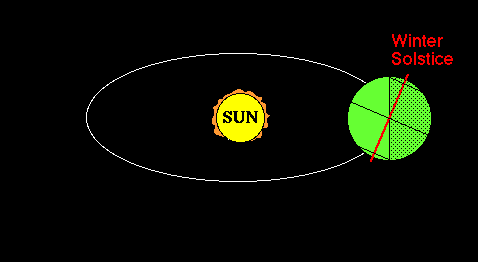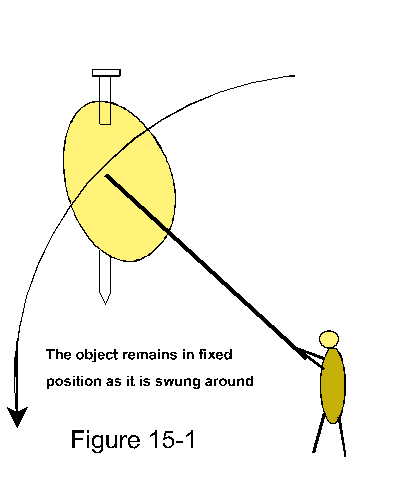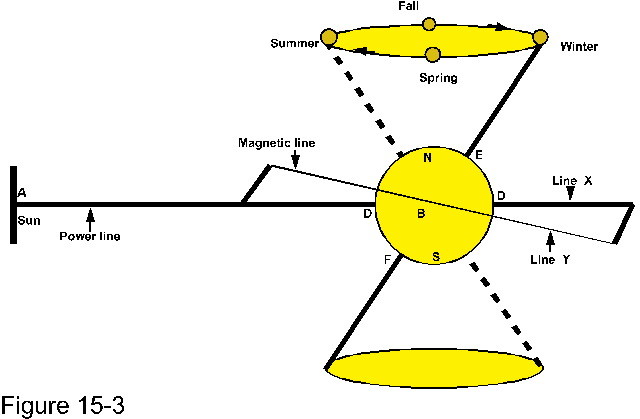

 O
R B I T A L
M
O T I O N
O
R B I T A L
M
O T I O N
THE SEASONS
(The animation above fails to show the precession upon the earth by which the seasons are brought about.)
Summer and winter come and go, a quantity of sunlight projected over a smaller or larger area can move us to sweat or put on an extra pair of socks.
Thus the temperature along
with the tilting of the earth in respect to our sun accounts for the change in
seasons. But just how does the
earth tilt in order to account for these seasons?
The earth makes four motions simultaneously.
1.
It travels at high velocity along with the rest of our solar system in an
angular mode within our galaxy.
2.
It orbits the sun.
3.
It spins at a rate of one revolution each 24 hours.
4.
It has a motion of precession, which it completes once each year.
It is by this last motion that we have our change in seasons. But until now the scientist's have not realized this fact of nature; they look upon the earth as were it a rigidly fixed rock in space with an immovable incline.
This observation now is not necessarily illogic since it can indeed appear that way, but insight knowledge is required to know the difference.
The laws of nature shown to me require an implementation of force in order for the earth to remain by an inclination that provides us with the season. A fixed rock would provide no seasons at all.
And to best demonstrate how there can be no seasons if indeed the earth were fixed in its position as claimed, we must make a mental image:

Swing a potato tied to a string around yourself (Figure 15-1). The nail driven into the potato signifies its axis, while the string is to be fastened at the center of center.
If
then we set the potato by its nail at a 23 degree incline (top 23 degrees away
from us), it will at all times maintain that position as it is swung around us.
But in that same position there will never be a change of seasons, which can only be true if the potato - as it moves around us - precesses one full turn for each orbital turn around us, in which case the string must slice vertically through the meat of the potato.
So thus the earth as a fixed rock will never show the seasons, just as the moon, which is indeed a fixed ball in space shows no seasons nor as such an axis about which it might rotate.
I might have been tempted to agree with ancient science had it not been for the fact that our magnetic and/or gravitational bond to our sun is in all respects very much like an indelible rope as were it tied from center to center.
The fact that the earth is, or acts as a "gyro" also adds to the account of the earth's movement of precession - without which there could be no seasonal change. A gyro has the natural tendency to precess whenever there is a torque placed upon its axis, and our 23 degree inclination as a result thereof.
But we should first look into the forces that constitute the bond between the sun and the earth in order to better define how and why the earth precesses. By illustration figure 15-3, let plane A, be our power center (sun's center).
The whole force of the sun thus pulls upon us as were it down a single line hooked unto our center. According to law therefore if a force of 10 be exerted at point D, then shall a force of 10 be exerted at all points B, E, and F as well.
Because the force - is not a force upon the "substance" as such, but upon the "force" of the object. Since then both these are designed after a figure eight - they propose a center from which seemingly all power goes out. The power thus is literally upon the whole of the force, but may be shown as from center.
The bond, which is magnetic, is a scheme of systematic motion that utilizes all substance of nature to conduct and extend itself.
And while centrifugal force has the entire line of the
earth's axis for a centering, magnetic force on the other hand has only a center
of center, establishing a single
vector point in
the equilibrium of its power in the center of the mass.
 Precession how and
why
Precession how and
why
Reference figure 15-3: As therefore the earth rotates in front of our sun, the rope that ties us together must cut right through the entire mass of the earth. And how may it be that the earth is not cut to ribbons by this rope?
The answer lies in the unique nature and design of what we have come to call magnetic force. The rope is in all respect a force and follows a line of as noted in the "defined" line of motion (line X), which is one half of its circle of motion - combining X and Y.
The key word here is "cycling," to cycle from one defined line to the next as the earth rotates with the magnetic rope slicing through the entire diameter thereof.
In any circle there are 360 degrees, and for each single rotation of the earth the magnetic lines of force of both the earth and the sun drive an precession upon the earth for one single degree. Therefore in 360 rotations or days as we call them the earth should complete a full turn of precession.
As in fact it does, wherefore also we are to number only 360 days in any year. But with the added variables that I shall define elsewhere, a full turn of rotation is added to each quarter of the year, bringing the reckoning of the year to 364 days. And by other factors these 364, are in essence the equal of 365-+ days, also defined elsewhere.

The ability now of this force of magnetic to rollover, to align and re-align upon all substance is indeed most marvelous, and a due factor of its nature in the principle by which it operates.
Following through on at least one cycle: The power of the sun's bond extends by the defined line X. Twelve (12) hours later the defined line noted Y will come in line with the line of the sun.
Meanwhile, a whole series of defined lines have passed upon it, all of which pass through the southern part of the globe below the equator. Then, crossing the center of the earth at the equator and the earth's axis - they pass on to exit north of the equator.
This applies since it is summer for the southern hemisphere, which in six months will be reversed as the axis has precesses by thus many cycles towards the sun. The line of the sun thus need never cut into anything but simply align with any one, or any number of lines from the earth's own magnetic force, thus establishing precessional movement, as well as orbital movement.
Here then is where precession comes in. Each 24 hours the sun's line completes upon a full figure eight which is one cycle of 366 by which the sun drives the earth into a single degree of precession.
By each cycle the earth is nudged one degree more as if there were groves in which the lines slide - moving the earth forwards into orbit and simultaneously driving a precession upon it.
Illustrating "dual figure eight"
Reference figure 15-4. The first figure eight (section A) completes one cycle each 24 hours at which point it has advanced as were it upon a track laid along a large coiled spring. In 366 advances therefore another figure eight is drawn (section B) which is the yearly cycle by which the seasons come about.
Four full seasons thus make for one full year, which, due to resistance, comes to 365-1/4 days. In these four seasons - it is the findings of our astronomers - that we also make one full orbital turn around the sun, with a difference of 1/26.000, which they obtained by triangulation with the North Star and Vega.
In addition to the 23 plus degree inclination caused by
precession, the earth is said to have a movement called "nutation" as
a precession brought upon us by our moon relative to us, which in the end
result comes out as an irregularity upon our precession.
If we question why the sun's power-line should incline our earth, - one answer might be to say because it is a magnet. And yet magnets can hold to one another by their forces squarely upon one another (Figure 15-5).
But
this is only true with magnets whose dimensions are near equal size; the smaller
magnets align in line
with the tracking of the defined lines. One
such example is found with our "compass" for which reason it cannot
point directly to magnetic north.
![]()
Leonard